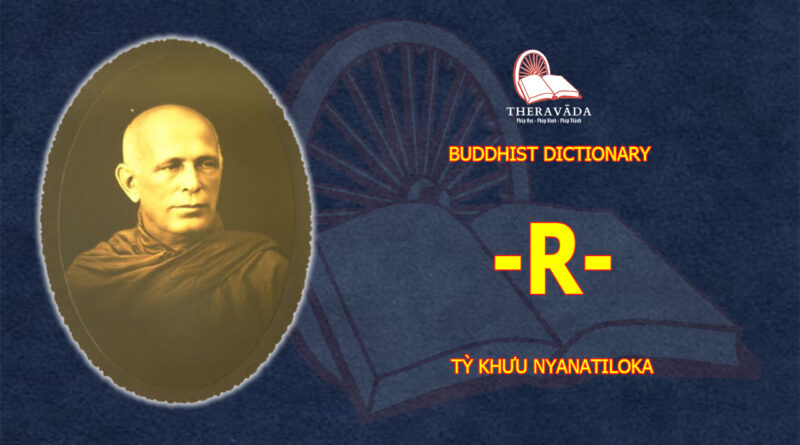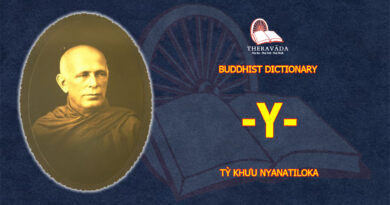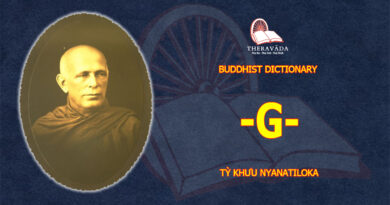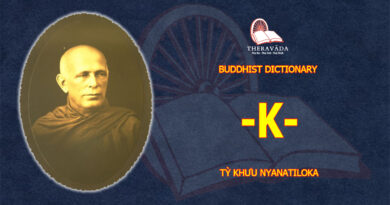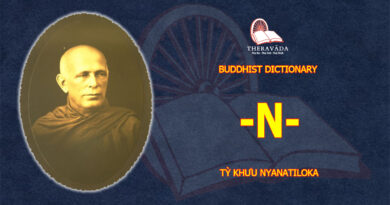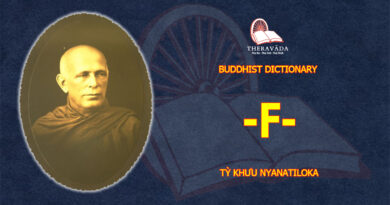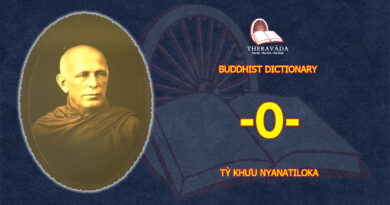BUDDHIST DICTIONARY
-R-
radiant gods: ābhassara; cf. deva.
rāga: ‘lust’, ‘greed’, is a synonym of lobha (s. mūla), taṇhā (q.v.) and abhijjhā (s. kammapatha). For kāma-, rūpa-, arūpa-rāga, s. saṃyojana.
rāga-carita: the ‘greedy-natured’; s. carita.
rapture: pīti (q.v.); further s. bojjhaṅga.
reaction, sense-: s. paṭigha.
ready-wit: s. paṭisambhidā.
reality: s. paramattha. – Vision and knowledge according to r.– s. vipassanā 15.
realization: For theory, practice and r., s. pariyatti .
rebirth: s. paṭisandhi, paṭiccasamuppāda (3,10), kamma, punabbhava.
receptive consciousness: sampaṭicchana-citta (s. viññāṇakicca).
recollectons: s. anussati.
red-kasiṇa exercise: s. kasiṇa.
reflecting contemplation: paṭisaṅkhānupassanā (s. vipassanā, 17).
reflection, power of: paṭisaṅkhāna-bala (q.v.).
reflex-perceptions: s. paṭigha (2a).
refuge-formula, the 3-fold: ti-saraṇa (q.v.).
regenerating process: upapatti-bhava (s. bhava).
regenerative kamma: janaka-kamma (s. kamma).
registering consciousness: tadārammaṇa-citta (s. viññāṇa-kicca).
relative truth: cf. puggala, paramattha-sacca, desanā, anattā, satta.
remembrance, of former existences: s. abhiññā 4.
remorse: kukkucca (q.v.).
repetition: āsevana-paccaya, is one of the 24 conditions (paccaya, q.v.).
repression, overcoming by: vikkhambhana-pahāna (s. pahāna).
repugnance: paṭigha (q.v.).
resistance-perceptions: s. paṭigha (2a).
restlessness: uddhacca (q.v.).
retrospective knowledge: paccavekkhana-ñāṇa (q.v.).
reversible merit: patti-dāna(q.v.).
right understanding (or r. view), r. thought, etc.: s. magga.
rise and fall (of phenomena): the knowledge consisting in the contemplation of r. and f., s. visuddhi VI, 1.
round of rebirth: s. vatta (2), saṃsāra . – The 3-fold r. of r. (s. vatta, 1).
rukkha mulik’anga: s. dhutaṅga.
rules and ritual, clinging to mere: (s. saṃyojana, upādāna).
ruminating-natured: vitakka–carita (s. carita).
rūpa: (1) corporeality (s. khandha 1); (2) visual object (s. āyatana); (3) fine-material (s. avacara, jhāna).
rūpa-jjhāna: s. jhāna.
rūpa-kalāpa: ‘corporeal group’, material unit, designates a combination of several physical phenomena constituting a temporary unity. Thus, for instance, the so-called ‘dead matter’ forms the most primitive group, consisting only of 8 physical phenomena, called the ‘pure eightfold unit’ or ‘octad’ (suddhaṭṭhakakalāpa), to wit: the 4 elements (the solid, fluid, heat, motion); colour, smell, taste, nutriment (paṭhavī, āpo, tejo, vāyo; vaṇṇa, gandha, rasa, ojā). In Vis.M., and elsewhere, it is also called ojatthamaka-kalāpa, ‘the octad with nutriment as the 8th factor’.
The simplest form of living matter is the ‘9-fold vitality unit’ or ‘life-ennead’ (jīvita-navaka-kalāpa), formed by adding ‘vitality’ to the octad. Seven decades, or units of ten (dasaka-kalāpa), are formed by adding to the 9-fold unit one of the following corporeal phenomena: heart (physical seat of mind), sex, eye, ear, nose, tongue or body. – See Vis.M. XVIII, 4; Compendium of Buddhist Philosophy (PTS), p. 164, 250; Aṭṭhasālinī Tr., II, 413f.
rūpa-kāya: ‘body-group’, as distinguished from nāma-kāya, ‘mind-group’ (q.v.). See nāma-rūpa.
rūpa-kkhandha: ‘corporeality group’; s. khandha (1).
rūpa loka: ‘fine-material world’; s. loka.
rūpārammaṇa: ‘visual object’, designates the external of visual physical phenomenon (‘light wave’) that forms the base consciousness. Cf. āyatana (2).
rūpa-rūpa = nipphanna-rūpa (q.v.).
rūpāvacara: s. avacara.
rūpāyatana: s. āyatana (2).

